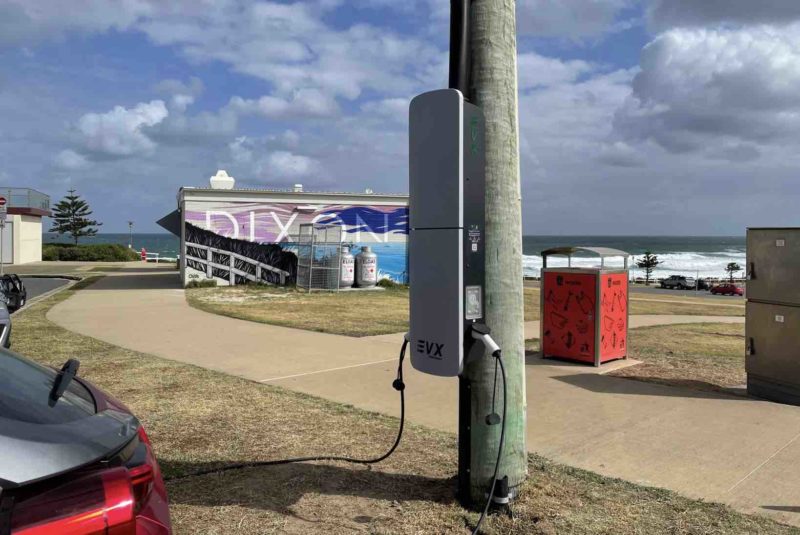It wasn’t that long ago that you could read stories and commentaries in Murdoch media – and maybe you still can – that purported to claim that electric vehicles and their charging stations would be too much for the local grid.
The idea has been firmly laid to rest by the CEO of Australia’s biggest distributed network providers, Ausgrid, which manages the grid in Sydney, the central coast and the Hunter Valley regions.
“We’ve never really subscribed (to the idea_ that too many EVs is going to blow up the grid,” Ausgrid CEO says in the latest episode of the weekly Energy Insiders podcast, which is published on The Driven’s sister site Renew Economy.
“And that’s certainly not the case in Ausgrid’s network, we’ve got plenty of capacity to absorb more demand. It’s reasonably straightforward for EVs to avoid that peak period at the end of the day.
“Anyone who owns an EV knows they don’t have to be charging all the time. They certainly don’t have to always charge at peak periods.
“So we see electric vehicles as an opportunity to increase the utilisation of the network and allow us to facilitate a reduction in bills for customer because the more people that use the network during troughs in the day when there’s lots of solar, the more we can spend our existing costs over a greater level of demand.
“And so we think it’s actually good overall, and that’s why we want to encourage it.
Indeed, Ausgrid sees its future as not just a provider of poles and wires, but also a storer of electricity (through battery storage, and community batteries in particular) and integrating EVs, and vehicle to grid technology.
But, England, says, before EVs can send power to the grid, the priority needs to be on getting the grids better at getting power to vehicles. That is easily done through home charging, but for those who don’t have that capability (apartment dwellers, those with no off street parking), the equation is not so simple.
England cites data that shows that public charging numbers are going backwards in Australia, at least in terms of numbers per EV. “In Australia today, we’ve got something like about 68 electric vehicles per public charger, while the global average is 11, so something’s not quite working,” he says.
“If you go back, I think I think it was 2022 Australia had 35 EVs per public charger. And we just aren’t seeing the growth in public charging that you’d expect.”
Ausgrid wants to do something about that, and of course sees an opportunity in boosting its business by rolling out hundreds of pole chargers, a sort of kerbside charging, and adding that to its regulatory base, which in turn adds to its revenues.
Some competitors are not happy with that, saying it gives Ausgrid and other network owners doing the same thing an unfair advantage by getting consumers to effectively underwrite the cost (through increased network bills).
England defends this, saying the benefits vastly outweigh the cost.
“We are making the argument that networks could play a role in accelerating that public chargingtollout and remove one of the barriers to people adopting EVs today.
“If one says, Well, why should a monopoly do that? Do we have an advantage? The total cost of 11,000 charges rolled out across our network by 2030 would be about $2 on the average bill. However, the utilization of another 600,000 EVs in the network, which is what the Australian Energy Market Operator’s ISP predicts over that period … would reduce bills by about $18.”
There are however, issues with the installation of fast-chargers across the network. And Ampol has complained that its planned rollout has been frustrated by network and connection delays.
“We often get finger pointed at us if things are not going to plan,” Ausgrid’s England says.
“A decent size fast charger (site) that Ampol wants to put in, for example, is about the size of about a 14 apartment building in terms of power demand So it’s not just plugging into a 10 amp socket, like a toaster or a hair dryer. It is a big bit of kit. Just like a new building is a big bit of kit, and it takes time.
:So it’s roughly about 110 business days to get a connection project up and running, and the construction can be up to 240 business days. And so I guess Ampol and others are probably learning that it does take a bit more time, and as a network we’re working really hard to try and slim that down.
“We’ve got new connections process we’re putting in place, and we’re seeing this potential wave of high power everything coming our way, and data centers are at the top end of that stack. That’s the difference between a low voltage curbside charger and a high powered charger on a highway.”
To hear Marc England speak in the latest episode of the popular and weekly Energy Insiders podcast, please click here.

Giles Parkinson is founder and editor of The Driven, and also edits and founded the Renew Economy and One Step Off The Grid web sites. He has been a journalist for nearly 40 years, is a former business and deputy editor of the Australian Financial Review, and owns a Tesla Model 3.


